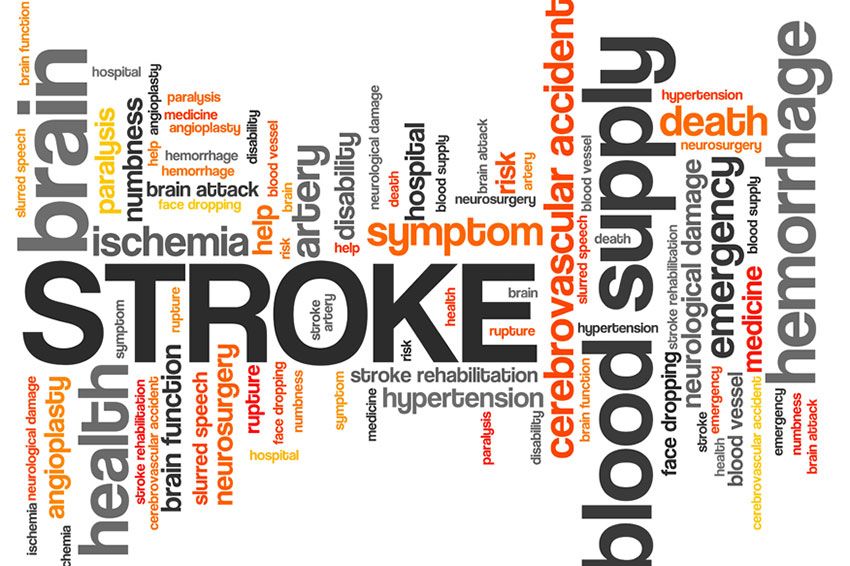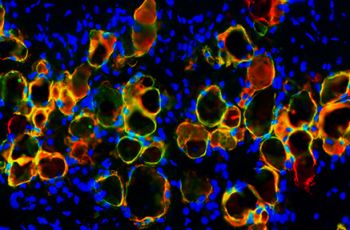
Last autumn, an ambulance rushed into the emergency entrance of George Washington University Hospital (GW Hospital) bearing a middle-aged woman who had developed an acute left-sided weakness that morning. Fearing a stroke, her family called 911. Upon examination, doctors assessed her as an 11 on the National Institutes of Health (NIH) Stroke Scale, evidenced by dysarthria (slurred speech), left facial droop, and severe left arm and leg weakness. An X-ray computed tomography scan (CT) of her head ruled out bleeding in the brain.
The patient was given IV tPa (intravenous clot-busting medication) less than an hour after symptom onset. A CT angiogram of the head showed a blood clot in the right middle cerebral artery. She was taken to the angio suite where neurointerventionalist Wayne Olan, M.D., assistant professor of neurological surgery, and colleague Dimitri Sigounas, M.D., assistant professor of neurological surgery, used a stent-retriever device to successfully remove the clot. After the procedure she had only mild left facial weakness and mild left hand incoordination. The woman was recently seen in the GW Medical Faculty Associates clinic and has subtle left facial droop but is otherwise back to normal. She is working, performing all of her activities of daily living, walking independently, and driving.
Stroke is a killer. Thanks to new procedures and proactive stroke prevention measures, stroke has, in the last decade, dropped to fifth from the third leading cause of death in the United States. Rapid response is crucial; quick recognition and treatment can save lives or minimize the long-term effects of a stroke. “Time is brain” is a key mantra of stroke neurology. Not long before the incident described above, GW Hospital was certified as a Comprehensive Stroke Center, a designation which may have saved the woman’s life.
What is a Comprehensive Stroke Center (CSC)? The designation recognizes the specific capabilities of hospitals that can treat the most complex stroke cases. Less than 2 percent of U.S. hospitals — less than 100 — have that certification. “It means that we have the clinical expertise to take care of complicated stroke cases,” says Christopher Leon-Guerrero, M.D., assistant professor of neurology at the GW School of Medicine and Health Sciences, who attends the stroke and general inpatient service at GW Hospital. “In addition to providing the routine care that Primary Stroke Centers can deliver, we can provide endovascular procedures on a 24/7 basis, and we’re actively engaged in research trials. It also means we have more vigorous metrics and measures that must be collected, so we’re constantly examining data and re-evaluating service to patients.”
The Joint Commission and American Heart Association/American Stroke Association instituted a new level of certification in September 2012 to identify the medical facilities with the resources, staff, and training, such as advanced imaging capabilities and specialized treatments, necessary for the care of complex stroke cases. “This designation demonstrates not only the unique expertise of our physicians, but also the exacting collaborative procedures that GW Hospital has developed involving everyone from the transport staff, technologists, nurses, and physicians to the CEO and hospital leadership,” says Henry Kaminski, M.D., chair of the Department of Neurology and Meta Amalia Neumann Professor of Neurology at SMHS.
GW’s CSC certification is good news for a region that sits at the northern end of the so-called “stroke belt,” a swath of mostly southern states stretching west to Texas with a high incidence of stroke. “The treatments that we now have,” says Leon-Guerrero, “have been proven to lower the amount of damage people suffer from strokes.” The evolution of advances in stroke treatment can be described in three categories:
Primary stroke prevention: Preventive measures, such as diet, blood pressure control, and exercise, can lower the risk of stroke.
Acute treatment: IV tPA (intravenous tissue plasminogen activator) clot-busting medication can be given in the first 4 1/2 hours to dissolve the clot and results in better clinical outcomes for patients.
Endovascular procedures: These are designed to restore perfusion to the brain in areas that are blocked off. For example, a stent-retriever or “stent-triever,” can be used to deploy a stent to pull the clot out of an artery. “We offer this to patients up to six hours from symptom onset,” says Leon-Guerrero. “The clot has to be in a blood vessel that’s reachable by catheter, a proximal large vessel occlusion. Some clots are so small that they are not amenable to this procedure.”
Leon-Guerrero says elapsed time is of the essence. “The earlier you treat, the more likely the patient will benefit,” he says. “These devices are also all time dependent.” Disagreement among practitioners remains over treating patients beyond the six hour mark. Another contentious issue is figuring out when to start the clock when a person wakes up with stroke symptoms. As of yet, no biomarkers in the blood have been discovered that could put a “time stamp” on onset.
Damage to the core of the brain is inevitable in virtually all strokes. The part of the brain not getting enough blood, but which is salvageable, is the penumbra (the cells surrounding a blockage where blood flow and oxygen levels are reduced). “The sooner we can restore profusion, the more of the penumbra we can save,” Leon-Guerrero explains.
When a person suffers a stroke, the treatment protocol shifts to secondary stroke prevention, aimed at reducing the risk of reoccurrence. GW Hospital has a 16-bed inpatient rehabilitation unit. “We use an evaluation system called the Functional Independent Measure, an ordinal scale from one to seven that determines the level of assistance the patient needs,” says Annu Sharma, D.O., instructor of neurology, who works in the rehab department at GW Hospital. The evaluation covers ambulation, transportation, mobility, and self-care, and it is scaled from total independence to maximum assistance needed.
Following the CSC certification, the unit has been receiving more referrals from stroke. Along with Ty Lai, M.D., instructor of neurology at SMHS, Sharma manages the unit and they determine, with the neurologist, how much daily therapy can be tolerated. “We have to be alert to changes in cognition during evaluation; whether a stroke might be getting bigger, or a new stroke is occurring,” she adds.
The benefits of aggressive therapy are substantial and relatively rapid. “We can see recovery in three to four weeks, sometimes in two weeks,” she says. “We see patients go from being significantly weak on one side to being able to have fully restored function.”
Among the basic requirements for a CSC is to treat 20 or more patients per year with a diagnosis of subarachnoid hemorrhage caused by an aneurysm and to administer IV tPA 25 or more times per year for eligible patients with acute ischemic stroke.
Leon-Guerrero says GW Hospital is expecting 600 to 700 stroke patients in 2016 and welcomes the new status the hospital has for serving the community. “I enjoy acute decision-making,” he explains. “I like to deal with patients who are faced with these unfortunate life-changing events, and neurology is filled with life-changing events. There’s a chance you can make a huge and lasting impact on someone’s life.”
This story originally ran in the Fall 2016 edition of Neurotransmitter, a joint publication of the George Washington University (GW) School of Medicine and Health Sciences, GW Hospital, and the GW Medical Faculty Associates.


